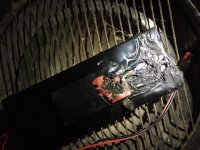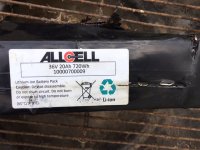Thanks for your responses everyone.
Yes I'm a beginner and this is my first e bike. I had been trying unsuccessfully to build a battery for the last few months and was relieved when a friend sold me this unused brand name pack.
I have not normally been running the pack down to LVC. This was only the second time it discharged that far.
I knew that the battery would not fully power my 35A controller or 1000W motor. At full throttle the CA3 was showing that the battery was delivering betw 15 and 20 amps.
My understanding was that the BMS would limit the demands of the controller, is that not correct ?
no, the bms can only cut the power, it can't actually limit the current. It's the motor controller that primarily controls the current. The current you are seeing, is likely just the result of the speed you are travelling and therefore power user, rather than any sort of limiting. That pack should be ok with a 35A controller, especially if you are not using it particularly hard, so that shouldn't be a concern
And I'm confounded by the Regen frying the BMS, as I thought that the whole point of the BMS was to limit power flow in and out to safe levels. It can't be that unusual to trip the LVC and on the same ride still use your brakes going downhill.
I was well aware of the damaging effects of heat, but I had not heard specifically that you should never put your controller in a bag with the battery.
most bms are not really intended to receive current through the discharge leads, as you get with regen. You can get away with it, but the bms wouldn't normally protect the pack from regen current. I and some others suspect the bms could have tripped, then the controller applied regen current to the tripped pack. That is not a normal situation and I'm a little surprised the controller could do that.
BMS have several functions. Preventing over discharge and excessive discharge current the discharge lead. Balancing out any high voltage cells when charged. Preventing any over charged cells when charged through the charge lead.
For the last few weeks after every ride I touched the battery and controller, and the controller would be slightly warm, not hot, and the battery was not warm at all.
However, on this last ride I put the battery and controller in a smaller bag, in an attempt to keep everything from flopping around less, which most have further trapped any heat produced. Although in the smaller bag, the pack and controller were side by side, just as they were in the larger bag, and the heating effects of the smaller bag didn't seem significant.
Cell_Man the reason I named this post Battery Fire is because when I opened the bike bag and then threw the battery on the ground, there were flames shooting out of the top of the pack, which I able to smolder with my sneaker.
As far as the picture above, at first I thought that the controller had burned through the shrink wrap and caused that rectangular line, but there's an equivalent line on the other side of the pack, must be a wiring pathway that heated up along with the BMS.
It seems that I relied too heavily on the BMS, and in the future I'll be sure to separate the controller from the pack.
Thanks again.



